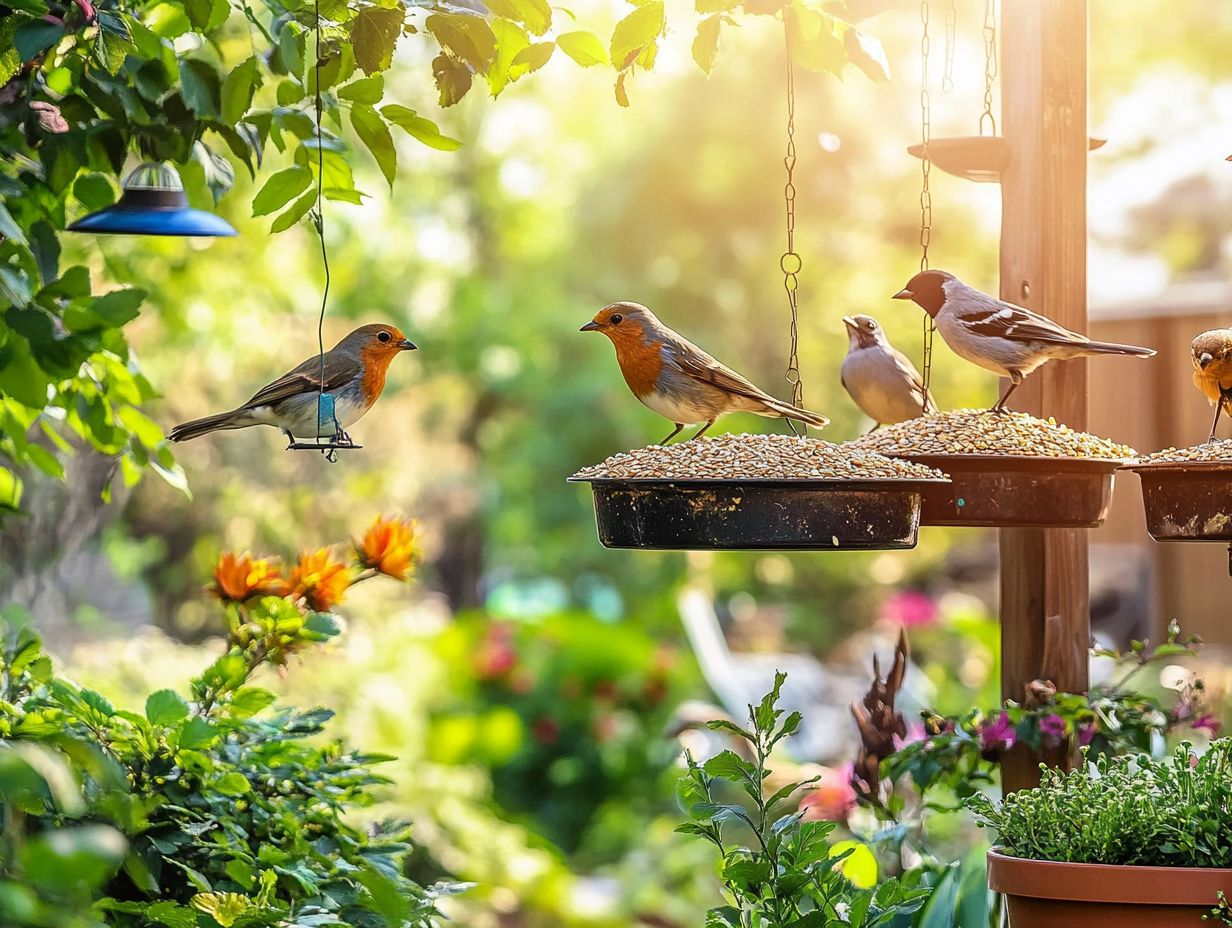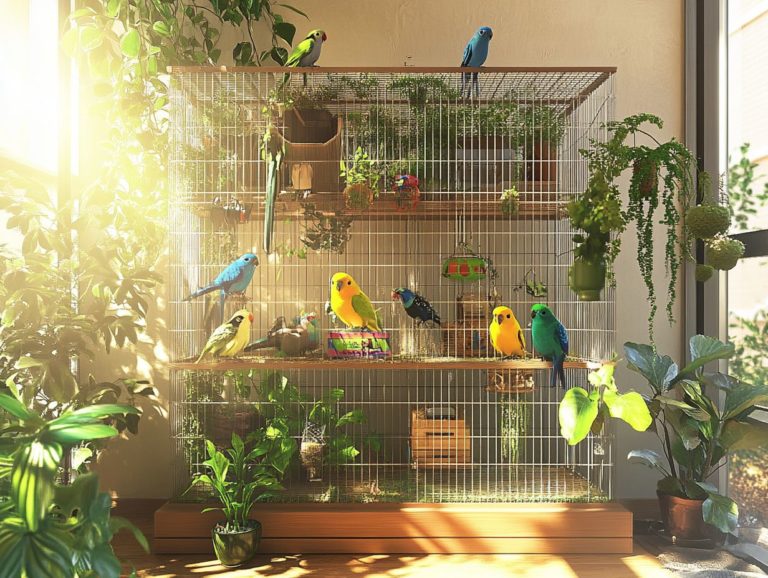Tips for Setting Up a Bird Feeding Station
Setting up a bird feeding station can turn your backyard into a lively haven for birds, inviting a delightful array of feathered friends while contributing to important conservation efforts.
This comprehensive guide provides you with all the essentials, from selecting the ideal location and choosing the right feeder designs to picking the most nutritious bird food available.
You ll also find expert tips on attracting specific species, maintaining a pristine feeding environment, and addressing common challenges that may arise.
Get ready to enjoy the beauty and excitement of birdwatching right at home!
Contents
- Key Takeaways:
- Why Set Up a Bird Feeding Station?
- Choosing the Right Location
- Types of Bird Feeders
- Types of Bird Food
- Attracting Specific Bird Species
- Maintaining and Cleaning the Feeding Station
- Dealing with Common Problems
- Frequently Asked Questions
- What are the essential items needed for setting up a bird feeding station?
- Where is the best location to set up a bird feeding station?
- What types of bird feeders and seeds attract the most birds?
- How can I prevent squirrels from stealing the bird seed?
- How often should I clean my bird feeder and feeding station?
Key Takeaways:

- Setting up a bird feeding station is beneficial for both bird watching and conservation purposes.
- The location of the feeding station is crucial in attracting different bird species, so consider factors such as safety, food accessibility, and visibility.
- Choose the right types of feeders and food to cater to the dietary needs of various birds. Research on the nutritional value and preferences of different species to attract them to your feeding station.
Why Set Up a Bird Feeding Station?
Setting up a bird feeding station in your backyard presents an exceptional opportunity to immerse yourself in nature while engaging in birdwatching and conservation efforts. This setup beautifies your outdoor space and helps local birds thrive, thus contributing to local biodiversity.
Bringing in different types of birds, from woodpeckers to finches, orioles, and cardinals, allows you to experience the captivating beauty of these feathered friends right in your own backyard.
Bird Watching and Conservation
Bird watching transcends mere leisure; it serves as a vital conduit for conservation, cultivating a deep appreciation for the health of birds and their habitats.
While enjoying birdwatching, you can become an advocate for protecting birds and their habitats. By joining local birdwatching groups, you can actively engage in community initiatives focused on habitat restoration, like planting native species that offer essential food and shelter for diverse bird populations.
Documenting and reporting your sightings can provide invaluable data to conservation organizations, aiding in tracking species populations and pinpointing areas in urgent need of protection. These efforts not only bolster biodiversity but also deepen your understanding of the intricate balance necessary to sustain healthy ecosystems. In this way, bird watching becomes a meaningful gateway to fostering environmental stewardship.
Choosing the Right Location
Selecting the perfect location for your bird feeding station is crucial for enticing a variety of backyard birds and fulfilling their essential habitat requirements. You ll want to choose a spot that offers safety from predators while also granting easy access to both food and water sources.
Consider the proximity to trees and shrubs, as these provide necessary shelter. Make sure your outdoor space stays quiet and undisturbed, creating a welcoming environment that won t send the birds fluttering away.
Factors to Consider
When selecting the perfect location for your bird feeding station, it’s essential to think about safety, accessibility, and visibility to entice a diverse array of birds.
To truly optimize bird visitation, you should carefully assess the height of the feeder, ensuring it s placed where birds feel secure yet remain easily visible. It’s equally important to position the feeder at a suitable distance from nearby cover, such as shrubs or trees. This setup provides birds not only with a hiding spot from predators but also a quick escape route when needed.
The type of feeder you choose can significantly impact your feeding success. For example, platform feeders may lure in ground-feeding species, while tube feeders are perfect for smaller, perching birds. Each of these factors plays a crucial role in enhancing the experience for both your feathered visitors and yourself as an observer.
Types of Bird Feeders

Get ready to explore a fantastic variety of bird feeders! Each one is designed to attract different bird species and meet various feeding preferences, from hanging setups to ingenious squirrel-proof designs.
Choosing the right bird feeders greatly enhances your bird feeding station’s effectiveness. You can attract delightful visitors like woodpeckers, hummingbirds, and finches with their favorite foods.
Different Designs and Uses
Bird feeders come in different designs that cater to specific feeding methods. These are tailored to accommodate the diverse dietary preferences of various bird species.
For instance, consider tube feeders; they’re perfect for smaller birds like finches and chickadees. Then, we have platform feeders, which attract larger species such as doves and jays. Each design plays a crucial role in fostering a welcoming habitat for birds, aligning with their feeding habits and preferred seeds.
To choose the right feeder, understand your local bird populations. Some areas may see a surge in activity from specific species.
For example, suet feeders are magnets for woodpeckers and nuthatches, while nectar feeders lure in dazzling hummingbirds. Evaluating these feeding behaviors allows you to create a vibrant birdwatching experience right in your own backyard.
Types of Bird Food
Selecting the right bird food is essential for nurturing healthy birds and enticing a captivating array of species to your feeding station.
Different birds have unique dietary needs. They require an assortment of foods such as seeds, nectar, and insects for optimal nutrition. By selecting the appropriate options, you support their well-being and enrich your birdwatching experience.
Common Options and Nutritional Value
You have a range of bird food options, including seed mixes, suet, and nectar. Each provides unique nutritional benefits for different bird species.
Seed mixes often feature a delightful assortment of seeds like sunflower, millet, and corn, delivering essential fats and proteins for seed-eating birds such as finches and sparrows. However, be cautious low-quality mixes may include fillers that offer little to no nutritional value.
Suet is packed with energy and is a favorite among woodpeckers and nuthatches. Be mindful of the weather; it can melt in warm temperatures, making it less suitable for some environments. Nectar, designed for hummingbirds, boasts high sugar content but requires frequent replacement to avoid fermentation.
For the best nutrition, look for reputable brands like Kaytee or Wagner s. They cater specifically to the dietary needs of various bird species, ensuring they thrive in their natural habitats.
Attracting Specific Bird Species
You can attract specific bird species to your backyard with targeted strategies. These strategies accommodate the unique preferences and behaviors of different birds. By understanding their needs and habits, you create an inviting environment that draws them in, transforming your outdoor space into a vibrant avian haven.
Tips for Attracting Different Types of Birds

Implementing specific tips can significantly enhance your success in attracting a delightful array of birds, including hummingbirds, woodpeckers, and finches, to your backyard feeding station.
Understanding the unique preferences of each species is essential. For instance, hummingbirds are particularly drawn to nectar-filled feeders. Place these in sunny spots and refresh them regularly with a sugar-water mix to keep them returning. Woodpeckers prefer suet feeders attached to tree trunks, giving them easy access to their dense food source.
Finches thrive on thistle seeds, which you can offer in tube feeders hung at heights that provide a sense of security from predators.
Don t miss out! Spring signals the arrival of migratory birds, making it the perfect time to enhance your feeding setups. By enriching your environment with native plants and water features, you create an inviting habitat that ensures a vivid avian spectacle throughout the year.
Maintaining and Cleaning the Feeding Station
Regular hygiene and maintenance of your bird feeders are crucial. This helps prevent disease and keeps your birds healthy.
Proper Hygiene and Maintenance Practices
To keep these charming companions in good health, clean your feeders frequently ideally, every two weeks. Start by disassembling the feeder, removing any leftover seeds, and taking apart any removable sections for a thorough clean.
Rinse all parts with warm water, then soak them in a solution of one part vinegar to nine parts water for effective sanitization. After soaking, rinse everything thoroughly to remove any residue.
Once the feeder is completely dry, reassemble it, ensuring that all parts are securely fastened. Don’t overlook the importance of maintaining clean water sources, such as bird baths, since dirty water can harbor harmful pathogens that jeopardize the health of your visiting birds.
Dealing with Common Problems
Navigating common issues like pests and squirrels can pose quite a challenge for bird enthusiasts. However, implementing effective solutions allows you to safeguard your bird feeders and preserve a serene feeding environment for your feathered friends.
Solutions for Pests and Other Challenges
Implementing effective solutions for managing pests and other challenges is crucial to keeping your bird feeders appealing to a diverse array of birds.
By embracing a variety of practical strategies, you can significantly decrease the chances of unwelcome visitors like squirrels and other critters raiding your bird feed. For example, choose squirrel-proof feeders equipped with clever mechanisms that thwart these cunning animals from reaching the seeds.
Place feeders away from tree branches or structures to deter pests effectively. Incorporating natural deterrents such as spicy seed mixes infused with cayenne pepper can help keep unwanted guests at bay without harming your birds.
Frequently Asked Questions

What are the essential items needed for setting up a bird feeding station?
You need a bird feeder, bird seed, a bird bath, and a birdhouse.
Where is the best location to set up a bird feeding station?
The best location is near trees or shrubs for birds to perch on and feel safe, but also in an area that is easily accessible for refilling and cleaning the feeder.
What types of bird feeders and seeds attract the most birds?
A platform feeder or hopper feeder works best for attracting a variety of bird species, as they can accommodate different seed types. Offer a variety of seeds like sunflower seeds, millet, nyjer seeds, and safflower seeds to attract different birds. Avoid seed mixes with filler ingredients like corn.
How can I prevent squirrels from stealing the bird seed?
You can use a squirrel-proof feeder or add a baffle to your existing feeder. Placing it at least 10 feet away from trees or structures can also help.
How often should I clean my bird feeder and feeding station?
It’s recommended to clean your feeder and feeding station at least once a month. If you see mold or other signs of bacteria, clean it immediately and consider changing the location to prevent buildup in the future.
Act now to keep your birds healthy! Clean your feeders regularly and enjoy the beauty of nature.






